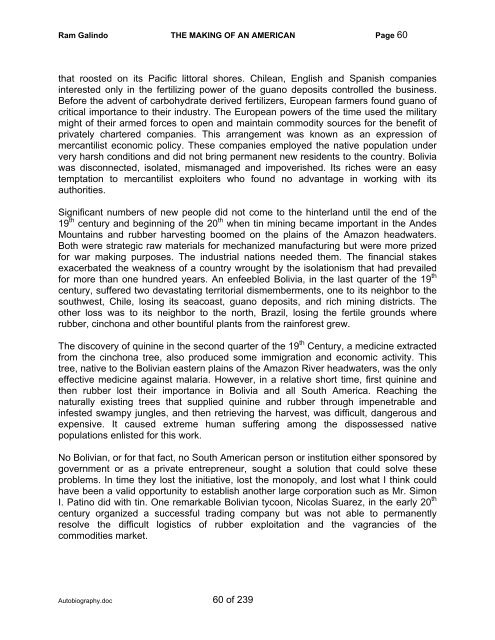Autobiography - The Galindo Group
Autobiography - The Galindo Group
Autobiography - The Galindo Group
Create successful ePaper yourself
Turn your PDF publications into a flip-book with our unique Google optimized e-Paper software.
Ram <strong>Galindo</strong> THE MAKING OF AN AMERICAN Page 60<br />
that roosted on its Pacific littoral shores. Chilean, English and Spanish companies<br />
interested only in the fertilizing power of the guano deposits controlled the business.<br />
Before the advent of carbohydrate derived fertilizers, European farmers found guano of<br />
critical importance to their industry. <strong>The</strong> European powers of the time used the military<br />
might of their armed forces to open and maintain commodity sources for the benefit of<br />
privately chartered companies. This arrangement was known as an expression of<br />
mercantilist economic policy. <strong>The</strong>se companies employed the native population under<br />
very harsh conditions and did not bring permanent new residents to the country. Bolivia<br />
was disconnected, isolated, mismanaged and impoverished. Its riches were an easy<br />
temptation to mercantilist exploiters who found no advantage in working with its<br />
authorities.<br />
Significant numbers of new people did not come to the hinterland until the end of the<br />
19 th century and beginning of the 20 th when tin mining became important in the Andes<br />
Mountains and rubber harvesting boomed on the plains of the Amazon headwaters.<br />
Both were strategic raw materials for mechanized manufacturing but were more prized<br />
for war making purposes. <strong>The</strong> industrial nations needed them. <strong>The</strong> financial stakes<br />
exacerbated the weakness of a country wrought by the isolationism that had prevailed<br />
for more than one hundred years. An enfeebled Bolivia, in the last quarter of the 19 th<br />
century, suffered two devastating territorial dismemberments, one to its neighbor to the<br />
southwest, Chile, losing its seacoast, guano deposits, and rich mining districts. <strong>The</strong><br />
other loss was to its neighbor to the north, Brazil, losing the fertile grounds where<br />
rubber, cinchona and other bountiful plants from the rainforest grew.<br />
<strong>The</strong> discovery of quinine in the second quarter of the 19 th Century, a medicine extracted<br />
from the cinchona tree, also produced some immigration and economic activity. This<br />
tree, native to the Bolivian eastern plains of the Amazon River headwaters, was the only<br />
effective medicine against malaria. However, in a relative short time, first quinine and<br />
then rubber lost their importance in Bolivia and all South America. Reaching the<br />
naturally existing trees that supplied quinine and rubber through impenetrable and<br />
infested swampy jungles, and then retrieving the harvest, was difficult, dangerous and<br />
expensive. It caused extreme human suffering among the dispossessed native<br />
populations enlisted for this work.<br />
No Bolivian, or for that fact, no South American person or institution either sponsored by<br />
government or as a private entrepreneur, sought a solution that could solve these<br />
problems. In time they lost the initiative, lost the monopoly, and lost what I think could<br />
have been a valid opportunity to establish another large corporation such as Mr. Simon<br />
I. Patino did with tin. One remarkable Bolivian tycoon, Nicolas Suarez, in the early 20 th<br />
century organized a successful trading company but was not able to permanently<br />
resolve the difficult logistics of rubber exploitation and the vagrancies of the<br />
commodities market.<br />
<strong>Autobiography</strong>.doc 60 of 239


